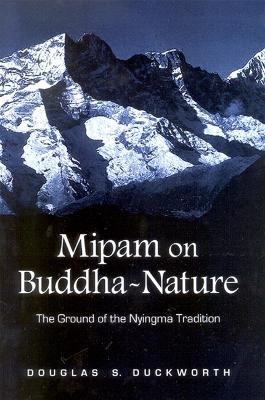
Mipam on Buddha-Nature
State University of New York Press (Verlag)
978-0-7914-7522-5 (ISBN)
Mipam ('ju mi pham rgya mtsho, 1846–1912) is one of the most prolific thinkers in the history of Tibet and is a key figure in the Nyingma tradition of Buddhism. His works continue to be widely studied in the Tibetan cultural region and beyond. This book provides an in-depth account of Mipam's view, drawing on a wide range of his works and offering several new translations. Douglas S. Duckworth shows how a dialectic of presence and absence permeates Mipam's writings on the Middle Way and Buddha-nature.
Arguably the most important doctrine in Buddhism, Buddha-nature is, for Mipam, equivalent to the true meaning of emptiness; it is the ground of all and the common ground shared by sentient beings and Buddhas. This ground is the foundation of the path and inseparable from the goal of Buddhahood. Duckworth probes deeply into Mipam's writings on Buddha-nature to illuminate its central place in a dynamic Buddhist philosophy.
Douglas S. Duckworth is Visiting Assistant Professor in the Department of Religious Studies at the University of North Carolina Greensboro.
Preface
Introduction
Presence and Absence
Historical Survey
Monastic Education and the Nonsectarian Movement
Life and Works of Mipam
Summary of Contents
The End of the Beginning
Chapter 1. Buddha-Nature and the Unity of the Two Truths
Introduction
Mipam’s Synthesis
Two Truths
Buddha-Nature as the Unity of Appearance and Emptiness
Buddha-Nature as the Definitive Meaning
Conclusion
Chapter 2. Middle Way of Prāsan˙gika and Yogācāra
Introduction
Svātantrika-Prāsan˙gika
Dialectical Ascent
Foundations of Yogācāra
Prāsan˙gika versus Yogācāra
Conclusion
Chapter 3. The Present Absence
Introduction
Other-Emptiness in the Jonang
Other-Emptiness and the Nyingma: Lochen Dharmaśrī
Another Emptiness? Emptiness of Self/Other
Phenomena and Suchness
De/limiting Emptiness
Emptiness as the Unity of Appearance and Emptiness
Conclusion
Chapter 4. Buddha-Nature and the Ground of the Great Perfection
Introduction
Distinguishing the Views on Buddha-Nature
Buddha-Nature as Heritage, Buddha-Nature as the Ground
Appearance and Reality
Conclusion
Chapter 5. The Indivisible Ground and Fruition
Introduction
Establishing Buddha-Nature: The Immanent Buddha
Establishing Appearances as Divine
Buddha-Nature and a Difference Between Sūtra and Mantra
Conclusion
Conclusion
Translations of Primary Texts
Appendix 1. Lion’s Roar: Exposition of Buddha-Nature
Stating Other Traditions
Presenting Our Authentic Tradition
The Meaning of the First Verse “Because the body of the perfect Buddha is radiant”
The Meaning of the Second Verse “Because thusness is indivisible”
The Meaning of the Third Verse “Because of possessing heritage”
Refuting the View that [the Basic Element] Is Truly Established and Not Empty
Refuting the View that [the Basic Element] Is a Void Emptiness
Refuting the Apprehension of [the Basic Element] as Impermanent and Conditioned
Appendix 2. Notes on the Essential Points of [Mipam’s] Exposition [of Buddha-Nature]
Notes
Bibliography
Index
| Erscheint lt. Verlag | 1.7.2009 |
|---|---|
| Zusatzinfo | Total Illustrations: 0 |
| Verlagsort | Albany, NY |
| Sprache | englisch |
| Maße | 152 x 229 mm |
| Gewicht | 454 g |
| Themenwelt | Geisteswissenschaften ► Religion / Theologie ► Buddhismus |
| ISBN-10 | 0-7914-7522-0 / 0791475220 |
| ISBN-13 | 978-0-7914-7522-5 / 9780791475225 |
| Zustand | Neuware |
| Haben Sie eine Frage zum Produkt? |
aus dem Bereich


